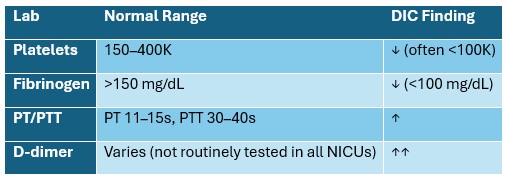
Disseminated Intravascular Coagulation (DIC) in the NICU
TDisseminated Intravascular Coagulation (DIC) in the NICU: A Cascade of Clotting and Bleeding
Disseminated Intravascular Coagulation—better known as DIC—is one of those diagnoses that sends a ripple of urgency through a NICU team. It’s complex, it’s critical, and it often shows up in our most vulnerable babies at their sickest moments. But DIC isn’t a standalone diagnosis. It’s not something that just happens. Instead, it’s a response to a bigger underlying problem—a serious infection, a hypoxic event, liver dysfunction, or something that triggers massive inflammation and tissue injury.
In the NICU, where babies are already at risk for immature clotting, fragile vessels, and inconsistent perfusion, DIC can quickly spiral. That’s why it’s so important to understand what DIC looks like, how it affects labs, and what interventions we can take as nurses to support early recognition and response.
What Is DIC?
DIC is a pathologic activation of the body’s clotting system. It begins when the clotting cascade is triggered by something like sepsis or HIE. The body starts forming clots throughout the microvasculature (often in the brain, lungs, kidneys, and liver). But then, clotting factors and platelets become consumed faster than they can be replaced.
The result? Bleeding. Lots of it. Babies may ooze from heelsticks and IV sites, bleed from the nose or mouth, and develop petechiae and bruising with minimal touch. It’s a paradox: they are both clotting and bleeding at the same time.
What Causes DIC in the NICU?
There are several major causes of DIC in our patient population. Most cases are linked to:
Sepsis, especially gram-negative organisms
Hypoxic-Ischemic Encephalopathy (HIE)
Necrotizing Enterocolitis (NEC) or other severe abdominal pathology
Meconium Aspiration Syndrome (MAS) or perinatal asphyxia
Liver failure, impaired clotting factor production
Hemolytic disease or hydrops fetalis
In each case, tissue damage and systemic inflammation disrupt the balance between clot formation and clot breakdown.
Lab Values in DIC: What to Expect
Spotting DIC early often depends on watching lab trends. Here’s what typically shows up:

In preterm infants, some of these values may already be borderline due to gestational age. But in DIC, we see dramatic drops and rises, especially in combination with clinical signs of bleeding.
Breaking Down the Labs: What They Mean and What We Do
Low Platelets
Platelets are essential for primary clot formation. In DIC, the platelet count drops rapidly, often below 100K, increasing the risk for spontaneous bleeding. Babies may bruise easily or ooze from sites.
Treatment: Platelet transfusions, especially if the baby is bleeding, has HIE, or is unstable. Thresholds vary but often <50K is treated actively.
Low Fibrinogen
Fibrinogen is needed to stabilize clots. When it drops below 100 mg/dL, clots can’t hold, and bleeding worsens.
Treatment: Cryoprecipitate is the product of choice to replace fibrinogen. Some providers may also use FFP.
High PT/PTT
Prolonged clotting times mean the body is slow to respond to bleeding. These elevated times reflect clotting factor depletion.
Treatment: Fresh Frozen Plasma (FFP) replenishes clotting factors and helps reduce bleeding risk.
High D-dimer
D-dimer is a byproduct of fibrin breakdown. In DIC, it spikes, showing us that clots are forming and dissolving rapidly. While not a treatment target, it’s a marker of severity.
What’s Happening in the Body?
Think of DIC as a cycle gone wrong:
A trigger causes widespread clot formation
The body uses up platelets and clotting factors
Organs begin to suffer from microclots and ischemia
The clotting system is exhausted—then bleeding begins
The body tries to break down the clots → D-dimer spikes
It’s this shift from clotting to bleeding that makes DIC both dangerous and difficult to manage.
Nursing Priorities and Bedside Interventions
NICU nurses are often the first to notice DIC. Key priorities include:
Watch for bleeding at all access sites, diaper areas, and around tubes
Minimize lab draws—bundle care and avoid unnecessary pokes
Hold pressure longer after blood draws
Track perfusion, urine output, and neuro status closely
Be prepared for multiple transfusions—platelets, FFP, cryo, and sometimes PRBCs
Communicate early changes in labs and bleeding patterns
Other Treatments
Ultimately, DIC won’t resolve without treating the underlying cause. That might mean:
Antibiotics and fluid resuscitation for sepsis
Therapeutic hypothermia for HIE
Surgical or medical management for NEC
Supportive care like gentle handling, thermoregulation, and cautious volume replacement can also help stabilize these fragile babies.
Communicating with Parents
DIC can be overwhelming for families. Use language that explains what is happening without adding fear.
🗣️ “Your baby is using up their blood's ability to clot, which can happen when they’re really sick.”
🗣️ “We’re giving them treatments and blood products to help stop the bleeding while we address the bigger problem.”
Provide frequent updates, be transparent, and emphasize the team’s focus on comfort and recovery.
In Summary
Disseminated Intravascular Coagulation is a complication, not a primary diagnosis, and it can develop rapidly in critically ill NICU patients. It begins with too much clotting and ends in a dangerous bleeding state. Nurses are at the frontline of recognition and support, from spotting early bruising to managing transfusions and helping explain complex care to families. By understanding the labs, the pathophysiology, and the bedside signs, you can make a real difference in outcomes.
Let’s keep learning and growing—one little bit at a time. 💙
